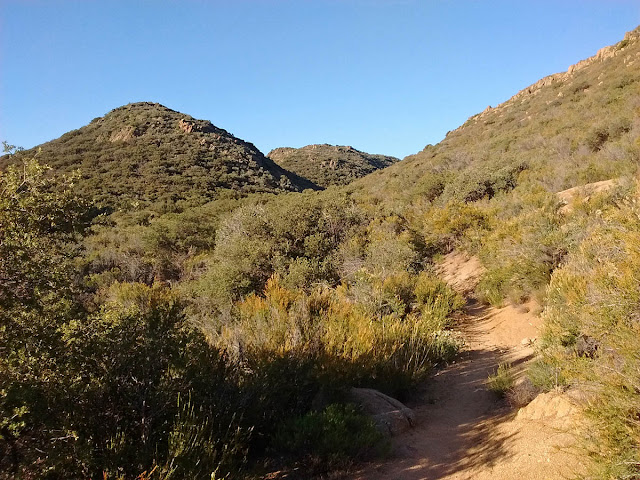I arrived on Rangeland road at 7:26 pm. It was overcast and muggy, about 81F. The first bird was a singing Blue Grosbeak on the fence line which then flew across Highland Valley Rd and into a lone oak. Scanning westward I noted 3 Cattle Egrets flying northward over the fields. I drove about 1/2 mile north, past two other cars full of birders waiting on the top of the hill east of the Ramona Water District reclamation pond (18022 Rangeland Rd, Ramona, CA 92065). Unfortunately, the nearby pond is not visible from the road.
Just beyond this, at the bottom of the rise, I stopped next to a longer-grass field, near a riparian area. It looked good for Grasshopper Sparrows, but I heard none. I could hear birds at the hidden pond--Great-tailed Grackles and Killdeer. Four White-faced Ibis flew north away from the pond. Three Black-necked Stilts flew in and descended into the pond area.
Right at sunset, however, (8:01 pm) two bird species became active. Some sparrow movement in the grass for the past few minutes finally gave a weak, barely audible, insect-like chirp-trill: Grasshopper Sparrows! And, over the ponds a couple of Lesser Nighthawks began flying around!
I had fortuitously positioned myself with a view of the sky above both the hidden pond to the SW and the other pond NW, visible westward from the end of Rangeland Rd. Since I was looking toward the setting sun, through clouds, the conditions were good for looking for silhouettes of flying nighthawks against the dimming sky.
Scanning and counting over both ponds, I reached the peak count about 8:15 pm. Off over the northwest pond a half mile were a maximum of 23 Lesser Nighthawks. Over the near pond, less than a quarter of a mile to the WSW I counted a maximum of 30 nighthawks in a continuous sweep of the skies with my binoculars. By 8:20 pm it was too dark to see nighthawks in the sky. The nighthawk show was over. But the Grasshopper Sparrows were now singing continuously in the near-dark.
I attempted photos of some of the nearest nighthawks, but it was just too dark for the camera to provide sharp pictures. Below, on photos I brightened, you can see the large head and crop, longer notched tail, long wings with a bend at the wrist that is held forward, slightly rounded wing tips, and a white wing patch just back from the tips.
| Lesser Nighthawk at dusk. Ramona, California. June 27, 2015. Greg Gillson. |
Additionally, for being so many summering birds, this comes from an area without previous local sightings of Lesser Nighthawks! Does that mean they were here all along, unseen? Or is this a new area for them? You can bet birders are going to return next year to see if they are here again.
John Bruin's eBird checklist from June 27, 2015 with photos of nighthawks.
Nancy Christenen's eBird checklist from June 26, 2015 with photos of nighthawks.





